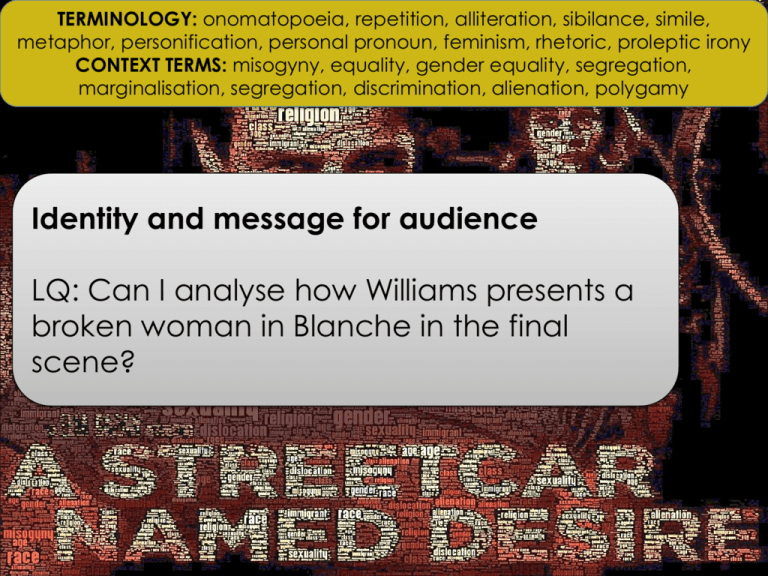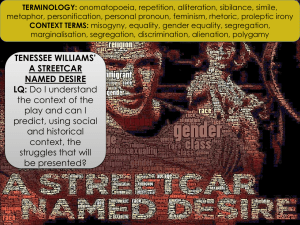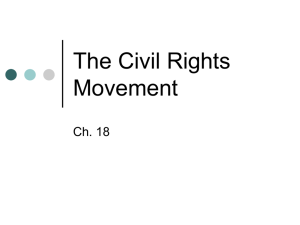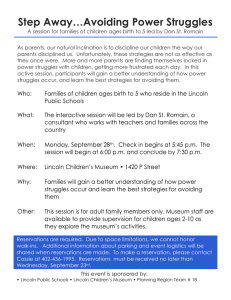context terms
advertisement

TERMINOLOGY: onomatopoeia, repetition, alliteration, sibilance, simile, metaphor, personification, personal pronoun, feminism, rhetoric, proleptic irony CONTEXT TERMS: misogyny, equality, gender equality, segregation, marginalisation, segregation, discrimination, alienation, polygamy Identity and message for audience LQ: Can I analyse how Williams presents a broken woman in Blanche in the final scene? TERMINOLOGY: onomatopoeia, repetition, alliteration, sibilance, postsimile, CONTEXTUAL TERMS: colonisation, independence, missionaries, metaphor, personal pronoun, feminism, rhetoric colonial, personification, racism, Empire, Victorian, Igbo, traditional custom CONTEXT TERMS: race, misogyny, equality, genderalienation, equality, segregation, STRUGGLES: cultural domination, religion marginalisation, segregation, discrimination, alienation, polygamy Identity and message for audience LQ: Can I analyse how Williams presents a broken woman in Blanche in the final scene? Use the blog: Justuslearning.com > blog > + search “Streetcar” TERMINOLOGY: onomatopoeia, repetition, alliteration, sibilance, postsimile, CONTEXTUAL TERMS: colonisation, independence, missionaries, metaphor, personal pronoun, feminism, rhetoric colonial, personification, racism, Empire, Victorian, Igbo, traditional custom CONTEXT TERMS: race, misogyny, equality, genderalienation, equality, segregation, STRUGGLES: cultural domination, religion marginalisation, segregation, discrimination, alienation, polygamy OUTSTANDING PROGRESS: I can articulate perceptive and detailed analysis of the ways the language, structure and form present struggles in the play, using my knowledge of social and historical context to illuminate alternative interpretations EXCELLENT PROGRESS: I can articulate perceptive analysis of the ways the language, structure and form present struggles in the play, using my knowledge of social and historical context GOOD PROGRESS: I can articulate my analysis of the ways the language, structure and form of the play present struggles TERMINOLOGY: onomatopoeia, repetition, alliteration, sibilance, postsimile, CONTEXTUAL TERMS: colonisation, independence, missionaries, metaphor, personal pronoun, feminism, rhetoric colonial, personification, racism, Empire, Victorian, Igbo, traditional custom CONTEXT TERMS: race, misogyny, equality, genderalienation, equality, segregation, STRUGGLES: cultural domination, religion marginalisation, segregation, discrimination, alienation, polygamy Who is the hero of the play? Why do we feel that? Evidence? EXT: if this is a tragedy, what is Blanche’s flaw? TERMINOLOGY: onomatopoeia, repetition, alliteration, sibilance, postsimile, CONTEXTUAL TERMS: colonisation, independence, missionaries, metaphor, personal pronoun, feminism, rhetoric colonial, personification, racism, Empire, Victorian, Igbo, traditional custom CONTEXT TERMS: race, misogyny, equality, genderalienation, equality, segregation, STRUGGLES: cultural domination, religion marginalisation, segregation, discrimination, alienation, polygamy Scene 11 Read the scene as a class. How is stagecraft used to emphasise Blanche’s “broken” state? EXT: what has “broken” her? OUTSTANDING PROGRESS: I can articulate perceptive and detailed analysis of the ways the language, structure and form present struggles in the play, using my knowledge of social and historical context to illuminate alternative interpretations EXCELLENT PROGRESS: I can articulate perceptive analysis of the ways the language, structure and form present struggles in the play, using my knowledge of social and historical context KEY INGREDIENTS: Point to answer question, Quotation, Technique, development of quotation with futher embedded quotations, social context TERMINOLOGY: onomatopoeia, repetition, alliteration, sibilance, postsimile, CONTEXTUAL TERMS: colonisation, independence, missionaries, metaphor, personal pronoun, feminism, rhetoric colonial, personification, racism, Empire, Victorian, Igbo, traditional custom CONTEXT TERMS: race, misogyny, equality, genderalienation, equality, segregation, STRUGGLES: cultural domination, religion marginalisation, segregation, discrimination, alienation, polygamy “The Matron advances on one side, Stanley on the other, Divested of all the softer properties of womanhood, the Matron is a peculiarly sinister figure in her severe dress. Her voice is bold and toneless as a firebell” TERMINOLOGY: onomatopoeia, repetition, alliteration, sibilance, postsimile, CONTEXTUAL TERMS: colonisation, independence, missionaries, metaphor, personal pronoun, feminism, rhetoric colonial, personification, racism, Empire, Victorian, Igbo, traditional custom CONTEXT TERMS: race, misogyny, equality, genderalienation, equality, segregation, STRUGGLES: cultural domination, religion marginalisation, segregation, discrimination, alienation, polygamy Each group should look at one of the women in the scene. Each group focus on different woman. How are they presented and how do they exhibit a side of the gender struggle? OUTSTANDING PROGRESS: I can articulate perceptive and detailed analysis of the ways the language, structure and form present struggles in the play, using my knowledge of social and historical context to illuminate alternative interpretations EXCELLENT PROGRESS: I can articulate perceptive analysis of the ways the language, structure and form present struggles in the play, using my knowledge of social and historical context KEY INGREDIENTS: Point to answer question, Quotation, Technique, development of quotation with futher embedded quotations, social context TERMINOLOGY: onomatopoeia, repetition, alliteration, sibilance, postsimile, CONTEXTUAL TERMS: colonisation, independence, missionaries, metaphor, personal pronoun, feminism, rhetoric colonial, personification, racism, Empire, Victorian, Igbo, traditional custom CONTEXT TERMS: race, misogyny, equality, genderalienation, equality, segregation, STRUGGLES: cultural domination, religion marginalisation, segregation, discrimination, alienation, polygamy OUTSTANDING PROGRESS: I can articulate perceptive and detailed analysis of the ways the language, structure and form present struggles in the play, using my knowledge of social and historical context to illuminate alternative interpretations FEEDBACK EXCELLENT PROGRESS: I can articulate perceptive analysis of the ways the language, structure and form present struggles in the play, using my knowledge of social and historical context KEY INGREDIENTS: Point to answer question, Quotation, Technique, development of quotation with futher embedded quotations, social context TERMINOLOGY: onomatopoeia, repetition, alliteration, sibilance, postsimile, CONTEXTUAL TERMS: colonisation, independence, missionaries, metaphor, personal pronoun, feminism, rhetoric colonial, personification, racism, Empire, Victorian, Igbo, traditional custom CONTEXT TERMS: race, misogyny, equality, genderalienation, equality, segregation, STRUGGLES: cultural domination, religion marginalisation, segregation, discrimination, alienation, polygamy How is gender presented in A Streetcar Named Desire? Students in groups brainstorm gender: • Quotations • Techniques • Social context point • Links to wider reading EXT: quotations from wider reading OUTSTANDING PROGRESS: I can articulate perceptive and detailed analysis of the ways the language, structure and form present struggles in the play, using my knowledge of social and historical context to illuminate alternative interpretations EXCELLENT PROGRESS: I can articulate perceptive analysis of the ways the language, structure and form present struggles in the play, using my knowledge of social and historical context KEY INGREDIENTS: Point to answer question, Quotation, Technique, development of quotation with futher embedded quotations, social context TERMINOLOGY: onomatopoeia, repetition, alliteration, sibilance, postsimile, CONTEXTUAL TERMS: colonisation, independence, missionaries, metaphor, personal pronoun, feminism, rhetoric colonial, personification, racism, Empire, Victorian, Igbo, traditional custom CONTEXT TERMS: race, misogyny, equality, genderalienation, equality, segregation, STRUGGLES: cultural domination, religion marginalisation, segregation, discrimination, alienation, polygamy OUTSTANDING PROGRESS: I can articulate perceptive and detailed analysis of the ways the language, structure and form present struggles in the play, using my knowledge of social and historical context to illuminate alternative interpretations PRESENT TO CLASS EXCELLENT PROGRESS: I can articulate perceptive analysis of the ways the language, structure and form present struggles in the play, using my knowledge of social and historical context KEY INGREDIENTS: Point to answer question, Quotation, Technique, development of quotation with futher embedded quotations, social context







